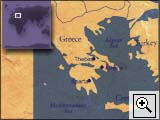
 The hydria was made during the sixth century B.C. in Greece. Relying on trade and farming, Greece was dominated by small independent city-states, such as Athens, Sparta, and Thebes. Pottery making was the first major industry to develop in Athens. Greek pots were made in a wide variety of shapes and sizes for both the local market and export. During this rich period the Greeks also adopted the Phoenician alphabet, built many classical monuments (such as the Parthenon on the Acropolis), and codified laws guaranteeing the rights of citizens.
The hydria was made during the sixth century B.C. in Greece. Relying on trade and farming, Greece was dominated by small independent city-states, such as Athens, Sparta, and Thebes. Pottery making was the first major industry to develop in Athens. Greek pots were made in a wide variety of shapes and sizes for both the local market and export. During this rich period the Greeks also adopted the Phoenician alphabet, built many classical monuments (such as the Parthenon on the Acropolis), and codified laws guaranteeing the rights of citizens.
 We
know the artist of this hydria only as the Antinaenes (an-TIN- en-eez)
Painter. Although many vase painters did not sign their work, art historians
can identify them by stylistic traits that recur in their paintings. The
Antinaenes Painter was the head of a large workshop and probably painted
hundreds of vases. His workshop was known for images of harnessing horses
such as the one on this vase. In most cases, two different artists worked
on the pots. The potter formed the pot, and the painter decorated it.
So, it is likely that another member of the Antinaenes workshop was responsible
for forming the vase.
We
know the artist of this hydria only as the Antinaenes (an-TIN- en-eez)
Painter. Although many vase painters did not sign their work, art historians
can identify them by stylistic traits that recur in their paintings. The
Antinaenes Painter was the head of a large workshop and probably painted
hundreds of vases. His workshop was known for images of harnessing horses
such as the one on this vase. In most cases, two different artists worked
on the pots. The potter formed the pot, and the painter decorated it.
So, it is likely that another member of the Antinaenes workshop was responsible
for forming the vase.
Key ideas.
Where does it come from?
What does it look like?
How was it used?
How was it made?
How big is it?
Who Knows?
Additional resources.
